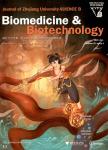Application Fourier transform near infrared spectrometer in rapid estimation of soluble solids content of intact citrus fruits
Application Fourier transform near infrared spectrometer in rapid estimation of soluble solids content of intact citrus fruits作者机构:School of Biosystems Engineering and Food Science Zhejiang University Hangzhou 310029 China
出 版 物:《Journal of Zhejiang University-Science B(Biomedicine & Biotechnology)》 (浙江大学学报(英文版)B辑(生物医学与生物技术))
年 卷 期:2006年第7卷第10期
页 面:794-799页
核心收录:
学科分类:080901[工学-物理电子学] 0809[工学-电子科学与技术(可授工学、理学学位)] 08[工学] 080401[工学-精密仪器及机械] 09[农学] 0804[工学-仪器科学与技术] 0803[工学-光学工程] 0902[农学-园艺学] 090201[农学-果树学]
基 金:Project supported by New Century Excellent Talents in University(No. NCET-04-0524) and the Research Fund for the Doctoral Pro-gram of Higher Education (No. 20030335060) of China
主 题:FT-NIR spectroscopy Soluble solids content Intact citrus Partial least squares analysis Reflectance mode
摘 要:Nondestructive method of measuring soluble solids content (SSC) of citrus fruits was developed using Fourier transform near infrared reflectance (FT-NIR) measurements collected through optics fiber. The models describing the relationship between SSC and the NIR spectra of citrus fruits were developed and evaluated. Different spectra correction algorithms (standard normal variate (SNV), multiplicative signal correction (MSC)) were used in this study. The relationship between laboratory SSC and FT-NIR spectra of citrus fruits was analyzed via principle component regression (PCR) and partial least squares (PLS) re- gression method. Models based on the different spectral ranges were compared in this research. The first derivative and second derivative were applied to all spectra to reduce the effects of sample size, light scattering, instrument noise, etc. Different baseline correction methods were applied to improve the spectral data quality. Among them the second derivative method after baseline correction produced best noise removing capability and yielded optimal calibration models. A total of 170 NIR spectra were acquired; 135 NIR spectra were used to develop the calibration model; the remaining spectra were used to validate the model. The developed PLS model describing the relationship between SSC and NIR reflectance spectra could predict SSC of 35 samples with correlation coefficient of 0.995 and RMSEP of 0.79 °Brix.



